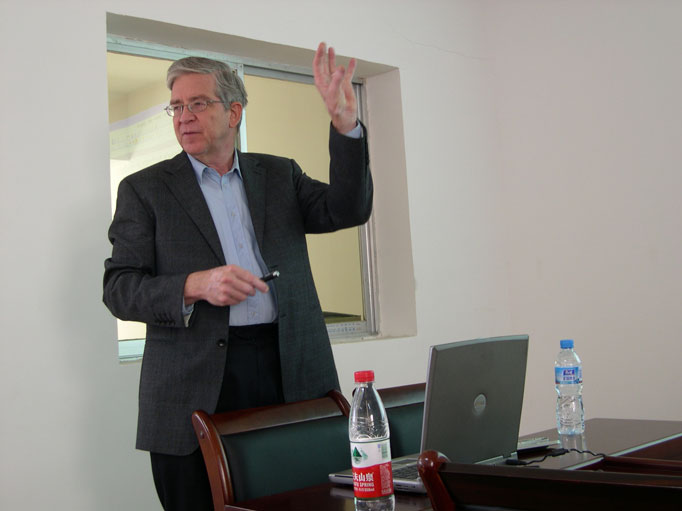

荷兰国家射电天文研究所资深教授Richard Strom博士到贵州大学进行学术交流
PDF download:
Lecture-1
| Lecture-2 |
Lecture-3
| Lecture-4
2010年10月22-26日,国家天文台特聘外籍天文学家、英国皇家学会会员、荷兰国家射电天文研究所资深教授Richard Strom博士到贵州大学进行学术交流。Strom教授是国际知名的射电天文专家,目前已经发表了200余篇学术论文,其中约10篇发表在著名的Nature和 Science 刊物上。其研究领域广泛,涉及超新星、超新星遗迹、脉冲星、伽马射线暴、射电星系等。Strom教授对正在贵州平塘县大窝凼建设的、世界上最大的500米球面射电望远镜 (FAST)非常感兴趣,他几次到贵州来,两次到FAST的台址联合考查。这次Strom教授专门到贵州大学,与贵大的师生进行学术交流与指导:除给贵大的老师、研究生及部分天文爱好者作四个报告外,Strom教授还热情的参观贵大的光学、电子实验室,与老师们探讨天文学科建设。


Summary of lectures
Lecture 1:
Introduction to radio astronomy: history, examples of
early attempts to detect radio emission from the sun; discovery by Jansky and
Reber’s first measurements; examples of research – radio emission from Jupiter,
supernova remnants, galaxies
射电天文简介:
射电天文的历史,例如早期探测太阳射电辐射;
央斯基与雷波的早期观测发现;射电天文研究介绍:木星,超新星遗迹,星系等的射电辐射。
Lecture 2: Single element radio telescopes;
description; what they measure; basic equations; stabilizing receiver – various
Dicke switch systems; how to estimate noise in measurement; single dish mapping;
different ways of feeding parabolic reflector; polarization
单面元射电望远镜系统介绍;
简单描述;它们可以观测什么;基本方程;接收机稳定性-各种狄克式交换系统;如何估算测量中的系统噪声;单天线连续成图;抛物面天线的各种接收方式;射电偏振。
Lecture 3: Interferometers: history and early
development; how they work; delay compensation; calibration; aperture synthesis;
general data reduction
干涉仪:
干涉仪的历史及其早期发展;
它们如何观测工作;
如何做延迟补偿;
校准;综合孔径;
数据处理。
Lecture 4: Frontiers of radio astronomy and some
of the technology involved: Nobel prizes in radio astronomy; future “prize”
research – black holes, extraterrestrial life, nature of dark matter.
Technology: state-of-the-art receivers; what to expect in the future – replace
analogue with digital, digitize signals as early as possible, optical fiber
signal transmission, improved interference suppression
射电天文研究的前沿领域以及其中所包含的一些技术:
诺贝尔奖与射电天文学;
将来的“诺贝尔奖“
领域:
各种各样的黑洞,
地外生命探索,暗物质的本质。
技术方面:
接收机的研究进展;
在可预期的将来-
数字技术取代模拟技术,
数字信号越早越好,
光纤信号传输,更好的抑制干扰能力。